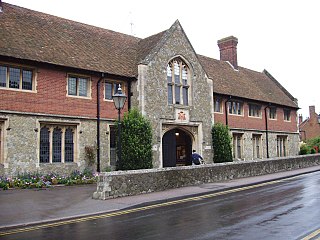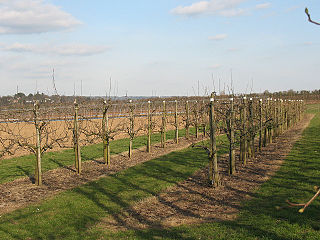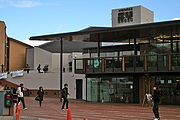Related Research Articles
The Scottish Crop Research Institute more commonly known as SCRI was a scientific institute located in Invergowrie near Dundee, Scotland. As of April 2011, when SCRI merged with the Macaulay Land Use Institute it is now part of The James Hutton Institute.

The College of St Gregory and St Martin at Wye, more commonly known as Wye College, was an educational institution in the small village of Wye, Kent, England, 60 miles (100 km) east of London in the North Downs area.
Long Ashton Research Station (LARS) was an agricultural and horticultural government-funded research centre located in the village of Long Ashton near Bristol, UK. It was created in 1903 to study and improve the West Country cider industry and became part of the University of Bristol in 1912. Later, it expanded into fruit research and in the 1980s was redirected to work on arable crops and aspects of botany. It closed in 2003. The Research Station is known for developing Ribena a still popular vitamin C-rich drink that was widely distributed in the UK during the Second World War.
The Faculty of Agriculture at Dalhousie University is a Canadian agricultural college and faculty of Dalhousie University located in Bible Hill, Nova Scotia. The Faculty of Agriculture offers the only university level programs in agriculture in Atlantic Canada. Founded 14 February 1905 as the Nova Scotia Agricultural College within the Nova Scotia Department of Agriculture, it merged with Dalhousie University on 1 September 2012. The campus is referred to as Dalhousie University's "Agricultural Campus" or by its popular nickname of "Dal AC" or simply the "AC."

Wellesbourne is a large village in the civil parish of Wellesbourne and Walton, in the county of Warwickshire, in the West Midlands region of the UK. In the 2001 census the parish, which also includes the village of Walton, had a population of 5,691. In the 2011 census this had increased to 5,849. The civil parish was renamed from Wellesbourne to Wellesbourne and Walton on 1 April 2014.

Anand Agricultural University (AAU) is located in the western Indian state of Gujarat between the cities of Vadodara and Ahmedabad. This was formerly the Anand Campus of Gujarat Agricultural University, which is now independent. It has three constituent colleges, for agriculture, veterinary science and animal husbandry and dairy science. The jurisdiction of the university covers Kheda, Anand, Ahmedabad, Vadodara, Dahod and Panchmahal districts. It was set up to provide education support to the farming community in areas such as Agriculture, Horticulture, Engineering, Information technology and Business Studies.

NIAB EMR is a horticultural and agricultural research institute at East Malling, Kent in England, with a specialism in fruit and clonally propagated crop production. In 2016, the institute became part of the NIAB Group.

Chaudhary Charan Singh Haryana Agricultural University is a public funded agricultural university located at Hisar in the Indian state of Haryana. It is the biggest agricultural university in Asia. The university has 8645 acres of land. It is named after India's seventh Prime Minister, Chaudhary Charan Singh.

The National Institute of Agricultural Botany (NIAB) is a plant science research company based in Cambridge, UK.

Agriculture in Kenya dominates Kenya's economy. 15–17 percent of Kenya's total land area has sufficient fertility and rainfall to be farmed, and 7–8 percent can be classified as first-class land. In 2006, almost 75 percent of working Kenyans made their living by farming, compared with 80 percent in 1980. About one-half of Kenya's total agricultural output is non-marketed subsistence production.
The College of Agriculture and Renewable Natural Resources (CANR) is one of the six colleges of Kwame Nkrumah University of Science and Technology in Ghana.

Lecanicillium lecanii is now an approved name of an entomopathogenic fungus species, that was previously widely known as Verticillium lecanii (Zimmerman) Viegas), but is now understood to be an anamorphic form in the Cordyceps group of genera in the Clavicipitaceae. Isolates formerly classified as V. lecanii could be L. attenuatum, L. lecanii, L. longisporum, L. muscarium or L. nodulosum. For example, several recent papers, such as Kouvelis et al. who carried out mitochondrial DNA studies, refer to the name L. muscarium.
Lecanicillium muscarium is the approved name of an entomopathogenic fungus species, that was previously widely known as Verticillium lecanii (Zimmerman) Viegas), but is now understood to be an anamorphic form in the Cordyceps group of genera in the Cordycipitaceae. It now appears that isolates formerly classified as V. lecanii could be L. attenuatum, L. lecanii, L. longisporum, L. muscarium or L. nodulosum. For example, several recent papers, such as Kouvelis et al. carried out mitochondrial DNA studies, refer to this name.
Regional Agricultural Research Station, Pattambi is a research Station under the Central Zone of Kerala Agricultural University at Pattambi in Palakkad district of Kerala, India.

The Indian Institute of Spices Research (IISR) is an autonomous organization engaged in agricultural research related to spices in India. The institute has its headquarters in Moozhikkal, Silver Hills, Kozhikode, Kerala and is a subsidiary of Indian Council of Agricultural Research (ICAR), New Delhi, under the Ministry of Agriculture, India.

The Indian Institute of Horticultural Research (IIHR) is an autonomous organization acting as a nodal agency for basic, strategic, anticipatory and applied research on various aspects of horticulture such as fruits, vegetable, ornamental, medicinal and aromatic plants and mushrooms in India. The institute has its headquarters in Bengaluru, Karnataka, India and is a subsidiary of Indian Council of Agricultural Research (ICAR), New Delhi, under the Ministry of Agriculture, India.
Krishna Lal Chadha is an Indian horticultural scientist, author and a former National Professor of the Indian Council of Agricultural Research. He was honored by the Government of India, in 2012, with the fourth highest Indian civilian award of Padma Shri.

College of Horticulture Mudigere is a horticulture college located in Mudigere, Karnataka, India. Established in 1991, it is affiliated to the University of Agricultural and Horticultural Sciences, Shivamogga and was previously affiliated to the University of Horticultural Sciences, Bagalkot. This horticultural education center is the oldest in Karnataka. The college has been accredited by the Indian Council of Agricultural Research since 25 August 2004.

Nicola Spence is the Chief Plant Health Officer and Deputy Director for plant and bee health at the Department for Environment, Food and Rural Affairs.
Rosemary H. Collier FRES is an entomologist and applied ecologist in the UK. In 2019 she became Professor at the University of Warwick.
References
- ↑ "Kirton Research Centre". University of Warwick. 2 March 2009. Retrieved 2 March 2009.
- ↑ "NVRS-HRI Google Group Archives". NVRS-HRI Google Group. Retrieved 13 December 2009.
- ↑ "School of Life Sciences, University of Warwick". University of Warwick .
- ↑ "VeGIN". University of Warwick .
- ↑ "Whats Going on at Wellsbourne? Warwick (HRI) Closure". sustainablefood.com.
